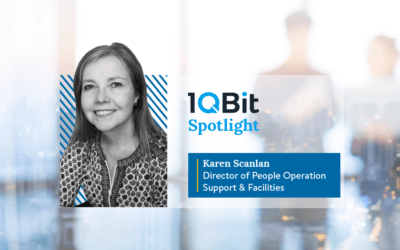The study of finance relies on making the best possible decisions despite future uncertainty. There is always risk when making financial decisions, and it goes hand in hand with return. A core problem in computational finance is risk minimization, and classical computers (that is, non-quantum computers) are often used to solve this problem using a variety of algorithms. But such methods are not always the solution. It will be explained below why there are limitations to using classical computers to solve challenging real-world financial problems, and what is being done to overcome these limitations by means of quantum computing.
“Quantitative finance has revolutionized the way risk minimization is done using well-thought-out algorithms on conventional computers. While this continues to be effective, sometimes real-world problems are too difficult to solve. Quantum computing has already shown strong potential to improve risk minimization.”
Some of these hard computational problems are in the areas of banking, insurance, and optimal investing strategies in financial markets. The main challenge in banking is to strategically set interest rates while managing risks related to liquidity, fraud, money laundering, or non-performing loans. Insurance companies seek the best way to maximize premiums while managing potential risks such as catastrophes or market crashes. Investment in the financial markets is focused on optimizing a financial portfolio, where funds are allocated across assets to maximize return at a given level of risk.

The Limits of Conventional Approaches to Managing Risk
Quantitative finance has revolutionized the way risk management is done by using effective financial algorithms on classical computers. While this continues to be effective, sometimes the problems are too computationally intensive for classical computers. On top of this, theoretical models are often too simplistic to accurately capture all the details present in real-world problems.
As an example, consider the problem of minimizing risk in portfolio optimization—mentioned above—to see what obstacles arise. In standard approaches, a so-called mean-variance model uses variance (the spread, or uncertainty around the mean) as a risk measure for a given expected return. This method can also be used to maximize the expected return for a given risk value.
This optimization problem can be solved efficiently by classical computers only if the assets’ returns are correlated in a simple manner.¹ What is meant by “a simple manner” is basically that the assets are not correlated (or dependent) on many other assets. Conversely, if many assets are correlated with many other assets, computational complexity can increase very quickly.
A common class of techniques for improving risk minimization is Monte Carlo simulation. These techniques rely on random sampling to create forecasting models. Among many other applications, they can be used for estimating risk metrics, pricing financial instruments, and performing economic stress tests. Still, Monte Carlo methods have their limits. For example, increasing confidence in numerical results by a factor of 10 requires an increase of computational resources by a factor of 100.²
The fact remains that most real-world financial optimization problems have assets that are correlated in a more complex way. These problems are much more difficult, if not impossible, to deal with using conventional computers. Such problems are known as “NP-hard” problems,³ and are the most difficult class of problems in computer science. It is explained below how quantum computing can be a promising approach for solving some of these hard problems.

Why Quantum Computing Can Be the Answer
Since the 1980s, there has been ongoing research in using quantum mechanics to solve certain hard problems much faster. This marked the inception of quantum computing as a discipline.³
The crux of quantum computing is in exploiting quantum mechanical properties of matter for computation. Instead of using bits, qubits (quantum bits) can be used to provide an exponential speed-up for certain challenging optimization problems. It has shown promising results for finance already, and the usefulness of quantum computing could increase as quantum technology is improved.
For example, it is known that the mean-variance portfolio optimization problem discussed above can be effectively solved by a quantum device known as a quantum annealer.⁴ A quantum annealer can have an optimization problem encoded into its qubits, and it will slowly evolve (anneal) to the optimized state under the influence of an applied magnetic field. For more information on how this quantum-inspired method can be used for solving other financial problems, please see the related article, Learn How Quantum-Inspired Algorithms Can Help You Make Safer Investments.
Beyond quantum annealing, a different kind of quantum hardware referred to as gate model quantum computers receive a lot of attention. Gate model quantum computers use logic gates as operations acting on qubits to carry out a computation. Because any computation is possible using gate model devices, they hold the most potential for quantum computing. However, these computers are still in the era of early development. It is a significant engineering challenge to scale up these gate model devices. Despite this, it is already recognized that gate model devices could provide speed-ups for general optimization and search algorithms. In particular, such speed-ups are applicable to portfolio optimization and risk analysis.⁵
For example, quantum amplitude estimation has been shown to provide a quadratic speed-up over classical Monte Carlo simulations for portfolio optimization.² To illustrate, a quadratic speed-up means that if a conventional Monte Carlo method has a runtime of one hour, the quantum amplitude estimation algorithm would only take around one minute to achieve the same result.
Even modest speedups for optimizing risk–return problems can have a large impact in terms of financial reward. So, it is likely that quantum computing will continue to be used as a tool to study computational finance, especially as quantum technology matures.
Summary
Quantitative finance has revolutionized the way risk minimization is done using well-thought-out algorithms on conventional computers. While this continues to be effective, sometimes real-world problems are too difficult to solve. Whether it is in the form of quantum-enhanced computing or gate model devices, quantum computing has shown strong potential to be effective for risk minimization. This suggests that further study should be done to explore the benefits of using quantum computing to solve challenging optimization problems.
As quantum technology is developed, solution potential is likely to increase. Eventually, quantum computers may even solve real-world problems that are impossible for conventional computers, but that may not happen for some time.
For now, the best approach is to make use of both the maturity of advanced conventional computing and emerging quantum technology to have the best possible optimization procedures available. The 1QBit cloud computing platform, 1Qloud, takes this approach to solve not only challenging portfolio optimization problems, but problems in logistics, the life sciences, and materials science. To learn more, visit 1Qloud.
References
¹ K. V. Fernando, “Practical portfolio optimization”, The Numerical Algorithms Group, Ltd, (2000).
² D. J. Egger et al., “Quantum computing for Finance: state of the art and future prospects”, IBM Quantum, (2020).
³ R. Orús et al., “Quantum computing for finance: Overview and prospects”, Reviews in Physics, 4, 100028, (2019).
⁴ G. Rosenberg et al., “Solving the optimal trading trajectory problem using a quantum annealer”, IEEE Journal of Selected Topics in Signal Processing (JSTSP), 10, 6, (2016).
⁵ P. Rebentros and S. Lloyd, “Quantum computational finance: quantum algorithm for portfolio optimization”, (2018).




